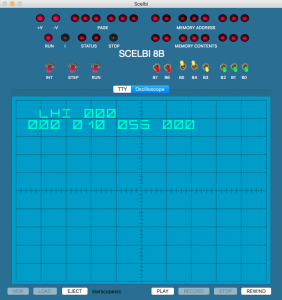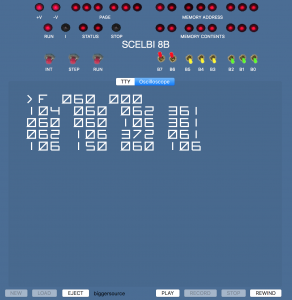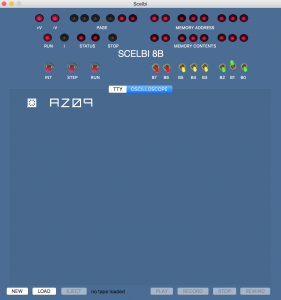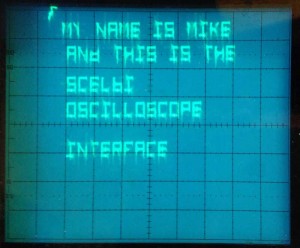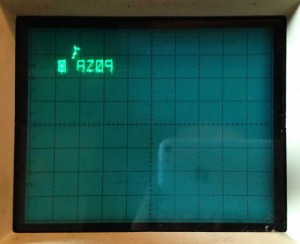I achieved this by changing out the .01 uF ceramic capacitors on the opamp inputs with .01 plastic film capacitors. I believe the lower ESR reduces the overshoot that can be seen as tails at the top and bottom of each character.
Author Archives: Mike
New Version of SCELBI App for OS/X in Apple App Store
Search for SCELBI in Apple’s app store. This version incorporates emulated Oscilloscope/CRT and Keyboard Interfaces. It also includes an option to switch page 76 of the MEA EPROM between TTY and an Oscilloscope drivers. Since they utilize different I/O ports, emulated hardware support for both is always present.
The emulation is good enough that I was able to completely debug a Oscilloscope driver for the MEA integrated development environment. Once burned into EPROM for a real SCELBI, it worked the first time.
The following screen shot shows the Oscilloscope window displaying a line of 8008 assembly code. Switching between TTY and oscilloscope screens is as easy as selecting the correct tab on the output window.
Due to the nature of analog electronics, the real oscilloscope display is not near as crisp and legible, as the emulated version. In fact, with the current hardware implementation, the physical device is pretty hard to read. I hope to be able to tweak some of the electronics on the analog board in order to improve things, but I’m not expecting miracles.
This version of the SCELBI app is only available from Apple’s app store and will not be available for free download from my website. The previous version, 2.7, will remain available for free download from my website. The idea with encouraging people to buy the app, is to generate enough revenue to pay for the cost of the annual Apple developer Fees. Without an Apple developer membership, I can’t finish the IOS version of the app.
SCELBI MEA working with Emulated Scope Interface
It pretty much works just like the manual suggests. Since it’s faster than the TTY, for tiny programs, it’s actually easier to use.
At this point, I’m working on a port of Starshooter. I plan to be able to demo it at VCF east. By that time, I should have the source moved over to the MEA environment, so you can assemble and run the program, natively.
Since the MEA scope driver seems to work OK and the original code can’t be found, here is a source listing for Page 76 of the Scope driver for MEA. Hopefully this version doesn’t get lost in the future.
AS8 assembler for intel 8008, t.e.jones Version 1.0
Options: listfile=1 debug=0 binaryout=0 singlelist=0
octalnums=1 markascii=1
Infile=oscope-pg76.asm
Assembly Performed: Sun Jan 22 14:21:20 2017Line Addr. CodeBytes Source Line
—- —— ———– ———————————-
1 ;
2 ; SUBROUTINES & MAINLINE TASKS AND A RAM
3 ;
4 ;
5 KEYIN: EQU 004 ; INPUT CHAR from KEYBOARD – MSB set if valid character
6 KEYOUT: EQU 012 ; ACK keyboard interface
7
8 OSCP0: EQU 8 ; SCOPE OUTPUT 0
9 OSCP1: EQU 9 ; SCOPE OUTPUT 1
10
11 ; TERMINAL DEPENDENT CONSTANTS
12 WIDTH: EQU 110 ; PRINTER WIDTH IN OCTAL
13 CR: EQU 15 ; CAR RET CHAR C ASC 1 I Cf\= 1 S
14 LF: EQU 12 ; LINE FEED CHAR (ASC I I LF=1 2>
15 ESC: EQU 175 ; ENTER COMMAND HOOE C ASCI I ESC= 17S )
16 ETX: EQU 3 ; CONTROL C EXIT TO STRT .
17 C: EQU 103 ; REQUIRED TO ECHO ETXr – c
18 UPARR0: EQU 136 ; REQUIRED TO ECHO ETX, -c
19 BLANK: EQU 040 ; space char
20
21
22 BUFFSZ: EQU 310
23 NUMCHR: EQU 151
24
25 NUMROW: EQU 5
26 NUMCOL: EQU 20
27
28 ORG 000#174 ; shared MEA variables
29 00-174 LNPTR: DATA *1 ; output pointer
30 00-175 ADPTR: DATA *2 ; used to clear screen memory
31
32
33 ORG 001#000
34 01-000 BUFFER: DATA *210
35
36 01-322 COLUM: DATA *1
37 01-323 ROM: DATA *1
38
39 ORG 076#000
40 ; ASCII TABLE OF DATA
41 ASCTAB:
42 76-000 000 000 DATA 000,000 ; @ – starburst
43 76-002 340 037 DATA 340,037 ; A
44 76-004 214 037 DATA 214,037 ; B
45 76-006 230 177 DATA 230,177 ; C
46 76-010 206 037 DATA 206,037 ; D
47 76-012 230 037 DATA 230,037 ; E
48 76-014 370 137 DATA 370,137 ; F
49 76-016 210 077 DATA 210,077 ; G
50
51 76-020 344 037 DATA 344,037 ; H
52 76-022 233 173 DATA 233,173 ; I
53 76-024 273 173 DATA 273,173 ; J
54 76-026 374 125 DATA 374,125 ; K
55 76-030 234 177 DATA 234,177 ; L
56 76-032 344 155 DATA 344,155 ; M
57 76-034 344 147 DATA 344,147 ; N
58 76-036 200 177 DATA 200,177 ; O
59
60 76-040 360 037 DATA 360,037 ; P
61 76-042 200 167 DATA 200,167 ; Q
62 76-044 360 027 DATA 360,027 ; R
63 76-046 211 037 DATA 211,037 ; S
64 76-050 373 173 DATA 373,173 ; T
65 76-052 204 177 DATA 204,177 ; U
66 76-054 174 175 DATA 174,175 ; V
67 76-056 144 167 DATA 144,167 ; W
68
69 76-060 177 145 DATA 177,145 ; X
70 76-062 177 155 DATA 177,155 ; Y
71 76-064 033 175 DATA 033,175 ; Z
72 76-066 230 177 DATA 230,177 ; [
73 76-070 377 147 DATA 377,147 ; \
74 76-072 203 177 DATA 203,177 ; ]
75 76-074 177 167 DATA 177,167 ; ^
76 76-076 237 177 DATA 237,177 ; _
77
78 76-100 377 177 DATA 377,177 ; space
79 76-102 277 173 DATA 277,173 ; !
80 76-104 367 175 DATA 367,175 ; ”
81 76-106 343 033 DATA 343,033 ; #
82 76-110 201 033 DATA 201,033 ; $
83 76-112 000 000 DATA 000,000 ; %
84 76-114 000 000 DATA 000,000 ; &
85 76-116 377 157 DATA 377,157 ; ’
86
87 76-120 230 177 DATA 230,177 ; (
88 76-122 203 177 DATA 203,177 ; (
89 76-124 177 000 DATA 177,000 ; *
90 76-126 377 033 DATA 377,033 ; +
91 76-130 177 176 DATA 177,176 ; ,
92 76-132 377 037 DATA 377,037 ; –
93 76-134 377 176 DATA 377,176 ; .
94 76-136 177 175 DATA 177,175 ; /
95
96 76-140 000 175 DATA 000,175 ; 0 – BLOCK 11;61;1 /0 through 9/
97 76-142 377 173 DATA 377,173 ; 1
98 76-144 222 037 DATA 222,037 ; 2
99 76-146 203 037 DATA 203,037 ; 3
100 76-150 345 037 DATA 345,037 ; 4
101 76-152 211 037 DATA 211,037 ; 5
102 76-154 210 037 DATA 210,037 ; 6
103 76-156 173 175 DATA 173,175 ; 7
104
105 76-160 200 037 DATA 200,037 ; 8
106 76-162 341 037 DATA 341,037 ; 9
107 76-164 277 137 DATA 277,137 ; :
108 76-166 177 172 DATA 177,172 ; ;
109 76-170 377 165 DATA 377,165 ; < 110 76-172 277 137 DATA 277,137 ; = 111 76-174 177 157 DATA 177,157 ; >
112 76-176 000 000 DATA 000,000 ; ?
113
114
115
116 ;
117 ; HERE IS THE ROUTINE TO READ FROM KEYBOARD INTERFACE
118 ; destroys C & D
119 ; returns character in A
120 INPUT:
121 76-200 346 LEL ; save H and L
122 76-201 335 LDH
123 ; LHI \HB\BUFFER ; buffer ptr into HL – MEA sets H to 1 before calling
124 DISP:
125 76-202 066 000 LLI \LB\BUFFER
126 76-204 016 151 LBI NUMCHR ; counter
127 ;
128 ; first refresh display
129 ;
130 DISP0:
131 76-206 307 LAM ;
132 76-207 121 OUT OSCP0 ; output first byte to port 0
133 76-210 060 INL ;
134 76-211 307 LAM
135 76-212 123 OUT OSCP1 ; output second byte to port 1
136 76-213 060 INL
137 76-214 011 DCB ; end of buffer?
138 76-215 110 206 076 JFZ DISP0 ; no, continue
139 ;
140 ; now check keyboard for input
141 ;
142 76-220 111 INP KEYIN ; read keyboard
143 76-221 240 NDA ; set sign if a new character present
144 76-222 120 202 076 JFS DISP ; no new character – continue refreshing display
145 ;
146 ; got a character
147 ;
148 76-225 125 OUT KEYOUT ; ack character read
149 76-226 364 LLE
150 76-227 353 LHD
151 76-230 007 RET
152 ; NDI 177 ; clear MSB
153 ; JMP OUTRET
154
155 ORG 076#232 ; echo entry point
156 ECHO:
157 76-232 104 235 076 JMP OUTPUT
158
159 ORG 076#235 ; write entry point
160 ;
161 ; conserves L,B and A, H = 0 on exit
162 ;
163 OUTPUT:
164 76-235 074 237 CPI 237 ; control character?
165 76-237 043 RTC ; yes, just exit
166 76-240 320 LCA ; save character
167 76-241 346 LEL ; save L
168 // LDH
169 76-242 044 077 NDI 077 ; STRIP 2 MSBS
170 ; lookup codes put into A and B
171 76-244 056 076 LHI \HB\ASCTAB ; POINT AT BEGINNING OF ASCTAB
172 76-246 002 RLC ; multiply by two
173 76-247 360 LLA ; becomes index into table
174 76-250 307 LAM ; fetch first byte
175 76-251 060 INL ; point to second byte
176 76-252 337 LDM ; fetch second byte
177
178 ; fetch and increment output buffer pointer
179 76-253 056 000 LHI \HB\ADPTR ; POINT to add location
180 76-255 066 175 LLI \LB\ADPTR
181 76-257 367 LLM
182 76-260 056 001 LHI \HB\BUFFER ; high
183 76-262 370 LMA ; SAVE high byte
184 76-263 060 INL
185 76-264 373 LMD ; save low byte
186
187 ; set up pointer for next write
188 76-265 056 000 LHI \HB\ADPTR ; POINT to add location
189 76-267 066 175 LLI \LB\ADPTR
190 76-271 337 LDM ; fetch out ptr
191 76-272 030 IND
192 76-273 030 IND
193 76-274 373 LMD ; increment it
194 76-275 302 LAC ; restore char
195 76-276 364 LLE ; restore H and L
196 76-277 007 RET ; return
197
198
199
200 ; zero entire buffer page
201 INIT1:
202 76-300 076 377 LMI 377 ; P0 output char to mem
203 INIT2:
204 76-302 060 INL
205 76-303 076 177 LMI 177 ; P1 output char to memory
206 76-305 060 INL
207 76-306 021 DCC ; at end of line?
208 76-307 110 300 076 JFZ INIT1 ; no, branch to continue
209 76-312 076 125 LMI 125 ; P1 output EOL
210 76-314 026 025 LCI 025 ; 21 characters (including EOL)
211 76-316 041 DCE
212 76-317 110 302 076 JFZ INIT2
213
214 76-322 060 INL
215 76-323 076 200 LMI 200 ; end of page
216 76-325 007 RET
217
218
219 ORG 076#343 ; init or clear screen entry point
220
221 ; caller must have H set up point to page zero
222 ; D must contain starting point of init function
223 INIT:
224 76-343 066 174 LLI \LB\LNPTR ;
225 76-345 307 LAM ; fetch start pointer
226 76-346 046 005 LEI 5 ; default 5 lines
227 INITX:
228 76-350 074 052 CPI 052
229 76-352 140 363 076 JTC INIT0 ;
230 76-355 041 DCE ; decrement lines
231 76-356 024 052 SUI 052 ; decrement character count
232 76-360 104 350 076 JMP INITX
233
234 INIT0:
235 76-363 012 RRC ; divide by two
236 76-364 330 LDA ; reduce count by offset
237 76-365 006 024 LAI 024 ; number of characters per line 20
238 76-367 223 SUD
239 76-370 320 LCA
240 76-371 060 INL
241 76-372 367 LLM ; fetch out ptr
242 76-373 050 INH ; point to output buffer
243 76-374 104 300 076 JMP INIT1
244
245 ORG 076#377
246 76-377 300 DATA 300
247
248
249
250
251
Symbol Count: 32
Symbol Oct Val DecVal
—— ——- ——
KEYIN 004 4
KEYOUT 012 10
OSCP0 010 8
OSCP1 011 9
WIDTH 110 72
CR 017 15
LF 014 12
ESC 175 125
ETX 003 3
C 103 67
UPARR0 136 94
BLANK 040 32
BUFFSZ 310 200
NUMCHR 151 105
NUMROW 005 5
NUMCOL 024 20
LNPTR 174 124
ADPTR 175 125
BUFFER 1 000 256
COLUM 1 322 466
ROM 1 323 467
ASCTAB 76 000 15872
INPUT 76 200 16000
DISP 76 202 16002
DISP0 76 206 16006
ECHO 76 232 16026
OUTPUT 76 235 16029
INIT1 76 300 16064
INIT2 76 302 16066
INIT 76 343 16099
INITX 76 350 16104
INIT0 76 363 16115
SCELBI App Progress on Oscilloscope Interface
I haven’t been getting very far in improving the SCELBI Oscilloscope software drivers. I think I was blocked, because I prefer not to spend time debugging software with actual vintage hardware. Emulators are so much easier to work with. Finally I bit the bullet and started work on adding Oscilloscope Interface emulator to my 8008 emulator.
I spent a marathon session working on this over the last day and half. This is a work in progress, but at least the 8008 driver I used to initially check out the real thing displays a few characters.
The interesting thing is that the part I feared the most, using the OS/X toolbox to draw the characters, actually has been the easiest part of this effort. OS/X embeds vector graphics primatives into the operating system, so drawing characters with vectors turned out to be pretty simple. Interfacing to the 8008 I/O instruction emulator also has proved to be pretty straight forward. Adding a tab to switch between TTY and Oscilloscope windows, was almost trivial.
I need to emulate the dynamic nature of the oscilloscope interface in order to make the emulator work right. Updating, erasing and changing the display is taking a lot of effort. Keep in mind that with the oscilloscope display, if the 8008 stops driving the output, the display disappears. The operation of the real thing is pretty dynamic, which isn’t something that computer displays do very naturally. There is some kind of animation support built into the OS/X toolbox, but I’m not sure I’m up for finding out if that will make my life easier.
Once I got started on this, I have been thinking about emulating scope controls, as well. By the time I’m done, I’ll might add some simple horizontal and vertical scaling controls, and perhaps some positioning controls. How much I do, if anything, remains to be seen.
SCELBI Keyboard and Oscilloscope PCBs now available
Note that this is a challenging project and at this point, documentation is not organized. You can download schematics and SCELBI documents from scelbi.com. Documentation is sparse, a few notes scattered among the MEA and SCELBI sales documents. My blog contains some of what I have learned, but not all of it.
The oscilloscope digital card requires rework, which is documented (incorrectly at this point) on my blog. I needed to make changes to the keyboard interface to make my PS/2 keyboard adapter work, and I’ve bypassed a resistor on the oscilloscope analog board in order to make blanking work better with my Tektronix 465. All that said, as far as I can tell at this point, the boards do match the original SCELBI designs.
Software is a work in progress. I’m working on the MEA compatible EPROM code this week. It will be quite different than the example code that I posted on my blog a few days ago.
Cost is $75 for the set of three boards.
I you are not in the USA, add $15 for international shipping.
Send email to mike@willegal.net for more information
PS/2 Adapter Software and Hardware CAD Files Now Available for Free Download
Go to my PS/2 adapter web page to find the links.
http://www.willegal.net/appleii/appleii-kb-int.htm
Support will be very limited. The firmware is actually rather sophisticated for what this device does. Understand that it is completely in assembler, and if you desire to make changes, it would be best if you were familiar with coding in assembler for micro-controllers.
Some scripts are included in the software package that are used to download the firmware, calibrate the built in RC oscillator and burn the fuses using a USB programmer called AVRdude. Fuses and EEprom must be programmed correctly or the micro-controller may not function correctly. The A version of the Atmel at tiny 2313 has not been tested. I have been using ATTINY2313V-10PU.
The CAD program I used to create the PCB is called Osmond PCB. I have also included GERBER and Postscript files. You must accept all risk associated with creating PCBs using any of these files.
Oscope Displays Several Lines of Text Which Were Input By the Keyboard Interface
I had to change resistor R33 on the analog board to 0 ohms in order to make blanking work reasonably well, but it’s still not perfect. Your mileage may vary depending upon the exact scope that you connect to this interface. I’d like to move onto focussing on getting some real software working, but I have one more significant issue to resolve. I think that the loading of the latches off the data bus is a little flakey, which is causing some flickering of the display. I also have to investigate the artifact at the top of the screen a little more.
In case you are interested, here is the driver that was used to generate the display in the picture. Keep in mind that it is a very much a work in the progress.
oscope-keyboard driver
Huzzah – Legible Scope Output
Still an artifact at the top, and I frequently see some dots flash on the screen (not seen in this image), but I’d say I”m almost there.
I had a couple of issues that had to be solved to get to this level.
The big one was that I had inverted the logic for displaying vectors. I had programmed ones in the registers to display lines and zeros to suppress vectors. The problem with that logic was that all the vectors that repositioned the cursor to the next position were enabled with this logic. I had to invert the output and use zeros to turn on vectors. Once I fixed this, I could easily adjust my Tektronix 465 to suppress vectors that were not to be displayed.
The second issue was that my rework instructions were wrong and had pins 1 and 3 swapped on Z3. This kept vector B2 enabled all the time.
Next step is to add the keyboard driver and check the vectors that I have programmed for the other characters and make sure the remaining lines and columns look OK.
SCELBI o-scope
I reversed the Y axis connections and tweaked the software some more.
This picture demonstrates that one remaining issue is related to the Z Axis. First 5 characters on first line are supposed to be starburst, space, A, Z, 0 and 9.
Seems like hooking the Z axis to my scope with a 10x scope probe causes a lot of latency in Z axis display, due to RC delay in the Z. The lag causes a line to be displayed, to actually not show, but the next line will show. Changing the probe to 1X causes Z axis to completely not function. Could be my Tektronix 465 isn’t compatible with the SCELBI design. I’ll have to investigate both the scope and the SCELBI O-scope implementation in order to find a good fix.
End of an Era for Me
As look back at some of the blog postings I made during the early days of the Mimeo project, the excitement I felt, could be easily discerned. For better or worse, after nearly 7 years, that excitement is no longer there, and it’s time to move the project over to someone who has a strong passion for that landmark system.
I’ve transitioned Mimeo 1 sales to Corey Cohen. I’m sure he will do a great job selling and supporting people interested in building reproduction Apple 1 Computers.
Since first making them available in March of 2010, I’ve sold 167 Mimeo PCBs, the first few as part of a kit, even a few that were completely assembled and tested. I have greatly enjoyed the entire process from creating the PCBs in the first place, to fixing a few boards that customers needed help with. Especially gratifying, has been the great relationship that I have established with all the people that I have made contact with over the years. One thing that I never expected, when starting this project, was the amazing contacts I made with so many people associated with Apple during those early years.
However, the learning part of the process, which is one of things that keeps me interested in my hobbies, has not been there over the past few years. It is time to move the sales over to Corey, who has unbelievable enthusiasm and knowledge for and about those milestone computers.
SCELBI PCBS
I will continue to sell SCELBI PCBs, as I am still excited about working on that system and learning a lot, while doing it. Blog followers will know that the Oscilloscope Interface PCBs, the last SCELBI boards that need to be reproduced, will soon become available to interested parties. I have some ideas for some even more obscure reproduction vintage computer projects. However, the Oscilloscope interface must be completed, before I move on to those projects.
Other Products
Other products I have sold in the past, will only be continue to be sold if I have remaining inventory in stock.
I presently have stock of the following
I am sold out of the following:
The PS/2 Keyboard Adapter
The PS/2 keyboard adapter is a little bit of a special item to me. When I had those PCBs made, because of economies of scale, I had 150 fabricated. I never thought I’d sell all of them. In the end, I sold over 140 those little dongles, using the others for a number of my own special projects. Though they probably exist, I have never heard of a PS/2 keyboard that it didn’t work with. It was designed to operate with Apple 1 and Apple II computers. As I originally hoped, people adapted the design to a number of systems beyond that. The firmware has had minor firmware features and improvements made over the years, but the basic design hasn’t changed over all these years.
There have been a number of other PS/2 keyboard to parallel ASCII keyboard adapters designed over the years, some coming before, and inspiring my adapter. Though it could certainly be improved further, I sincerely believe my version is currently the best of the breed.
When I get the time to add them to my web site, I will be releasing to the public domain, with no restrictions, all design files, including firmware and PCB CAD files. You will be able to do what you want with it, make copies for sale, improve it, or just study the design for your own purposes.


